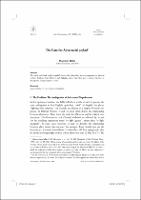Please use this identifier to cite or link to this item:
https://hdl.handle.net/20.500.12202/4373Full metadata record
| DC Field | Value | Language |
|---|---|---|
| dc.contributor.author | Holtz, Shalom E | - |
| dc.date.accessioned | 2019-05-14T18:50:49Z | - |
| dc.date.available | 2019-05-14T18:50:49Z | - |
| dc.date.issued | 2009 | - |
| dc.identifier.citation | Holtz, Shalom E. (2009). The case for adversarial yahad. Vetus Testamentum 59(2), 1-11. | en_US |
| dc.identifier.issn | 0042-4935 | - |
| dc.identifier.uri | https://doi.org/10.1163/156853309X413327 | en_US |
| dc.identifier.uri | https://hdl.handle.net/20.500.12202/4373 | - |
| dc.description | research article | en_US |
| dc.description.abstract | The words yaḥad and yaḥdāw regularly denote the relationship between opponents in physical warfare. Evidence from Hebrew and Akkadian shows that they have a similar function in descriptions of legal disputes, as well. | en_US |
| dc.language.iso | en_US | en_US |
| dc.publisher | Brill Academic Publishers | en_US |
| dc.relation.ispartofseries | Vetus Testamentum;59(2) | - |
| dc.rights | Attribution-NonCommercial-NoDerivs 3.0 United States | * |
| dc.rights.uri | http://creativecommons.org/licenses/by-nc-nd/3.0/us/ | * |
| dc.subject | yahad | en_US |
| dc.subject | yahdaw | en_US |
| dc.subject | 'et | en_US |
| dc.subject | 'im | en_US |
| dc.subject | forensic terminology | en_US |
| dc.title | The case for adversarial yahad. | en_US |
| dc.type | Article | en_US |
| local.yu.facultypage | https://www.yu.edu/faculty/pages/holtz-shalom | |
| Appears in Collections: | Bernard Revel Graduate School of Jewish Studies (BRGS): Faculty Publications | |
Files in This Item:
| File | Description | Size | Format | |
|---|---|---|---|---|
| Holtz proof Case for adversarial VT 2009.pdf | pre-publication Holtz | 167.37 kB | Adobe PDF |  View/Open |
This item is licensed under a Creative Commons License

